In this article, we’ll look at the key differences between AdGuard Home vs. Pi-hole. AdGuard Home and Pi-hole are network-wide adblockers that function as a DNS sinkhole to block ads. Unlike other ad-blocking technology, AdGuard Home and Pi-hole function at the DNS level, which means that they can block ads for all devices connected to them (as a DNS server).
The easiest way to ensure that all devices block ads on a specific network is to set up AdGuard Home or Pi-hole and force the router on the local network to use that as the DNS server. This will ensure that all clients using DHCP will automatically use AdGuard Home or Pi-hole.
We will look at a side-by-side comparison of Pi-hole vs. AdGuard Home below, but please keep in mind that these systems are very similar and they both function well.
Some links below are Amazon affiliate links which means that I earn a percentage of each sale at no cost to you. Thank you for your support.
What is a DNS Sinkhole?
In the simplest terms, a DNS sinkhole is a method used to reroute traffic in a network, with the primary intention of blocking or redirecting specific domains. Whether you use AdGuard Home or Pi-hole, they’re both designed with the goal of rerouting or entirely dropping requests based on rules defined in the application.
There are several reasons why you’d want to use one, but two major ones are security and ad-blocking. From a security perspective, they are commonly used to protect networks from threats. For instance, if a malware command and control center is known to use a specific domain, a DNS sinkhole could be configured to redirect any traffic destined for that domain to a safe address, effectively neutralizing the threat.
In the case of ad blocking, they can be used at the network-level to prevent ad-serving domains from reaching your devices, providing a cleaner, faster browsing experience. This is the main reason why we’re comparing AdGuard Home vs. Pi-hole in this article.
Device Compatibility with AdGuard Home and Pi-hole
AdGuard / AdGuard Home
While you can set up AdGuard Home and Pi-hole as network-wide ad blockers (and it’ll function better as it’ll impact all devices), AdGuard Home is unique in the sense that they offer a Windows, Mac, Android, and iOS app (called AdGuard) that allow you to specify a specific browser where ads will be blocked.
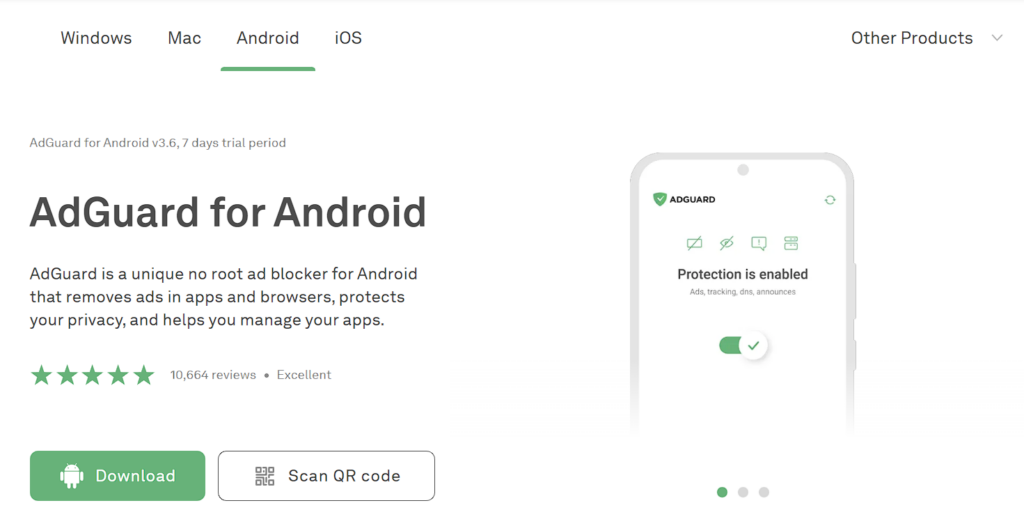
This is an important point to make because AdGuard is not the same product as AdGuard Home. If you’re interested in simply blocking ads on a browser level, there are a ton of different products that you can use.
AdGuard Home, on the other hand, is a product that will allow you to configure a specific device to run the application and be used as your DNS server.
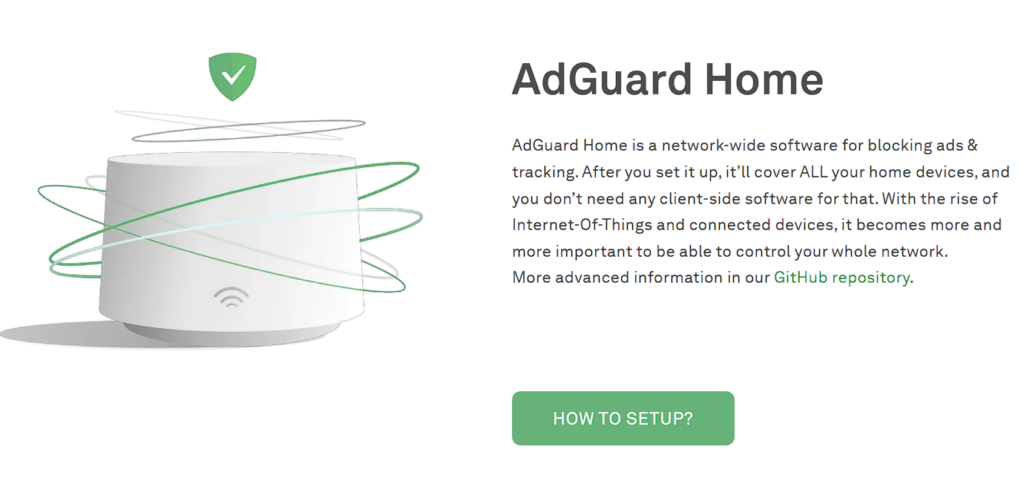
Various devices can run AdGuard Home, with some of my favorites being a Synology NAS, Raspberry Pi, or OpenMediaVault. If you don’t have any of the devices listed above, your best bet is to purchase a Raspberry Pi as it’s extremely powerful for the form factor and runs AdGuard Home very well.
Pi-hole
Unlike AdGuard Home, Pi-hole does not offer standalone products. If you’re interested in using Pi-hole, you must install the product on one of the various operating systems supported.
The easiest way to install Pi-hole is using Docker and support is broad for Docker, meaning that you can get Pi-hole working on a Synology NAS, OpenMediaVault, or really any device that can run Docker. If you’d rather install Pi-hole only (and avoid Docker), you can get it to work on Proxmox or a Raspberry Pi.
As mentioned above, if you don’t have any of the devices listed above, your best bet is to purchase a Raspberry Pi as it’s extremely powerful for the form factor and runs Pi-hole extremely well.

Differences Between AdGuard Home and Pi-hole Ad Blockers
The main difference between AdGuard Home and Pi-hole is the privacy features they offer. While AdGuard Home has native support for DNS-over-HTTPS, Pi-hole doesn’t but excels with its large community support.
There are other core differences between both, and for this reason, I will attempt to highlight some of the items that I consider the most important differences between AdGuard Home and Pi-hole. We will also look at some of the similarities to give you the full picture of how both function.
Before getting to that step, I want to be sure to mention that the setup process for each of these services is very similar – one isn’t easier than the other. It’s also a one-time setup to get everything functional in AdGuard Home or Pi-hole.
This is a quick chart to highlight some of the key differences between AdGuard Home and Pi-hole before looking at more in-depth differences below.
| Feature | AdGuard Home | Pi-hole |
|---|---|---|
| Platform Support | Windows, macOS, Linux, Raspberry Pi, Docker | Linux, Raspberry Pi, Docker |
| DNS-over-HTTPS/TLS | Built-in support | Requires additional setup (using third-party tools) |
| Filtering Rules Syntax | AdGuard-specific syntax; supports more complex rules | Standard DNS filtering rules |
| Web Interface | Modern, user-friendly interface | Simple, functional interface |
| Block Page Customization | Limited customization | More customizable block page |
| Parental Control | Built-in support for parental control features | Lacks built-in parental control features |
| Performance | Comparable performance | Comparable performance |
| Regular Expressions | Supports regular expressions in filters | Supports regular expressions in filters |
| Automatic Updates | No built-in automatic updates | Built-in automatic updates for blocklists and core components |
| Community Support | Growing community | Larger, well-established community |
Default Ad-Blocking: AdGuard Home vs. Pi-hole
When you configure AdGuard Home or Pi-hole, there are default blocking lists that are used. In AdGuard Home and Pi-hole, these lists can be configured and the experience is extremely similar out of the box.
By default, I find that the AdGuard Home and Pi-hole block roughly the same number of ads (from an effectiveness standpoint). However, they both tend to miss a lot (with the default blocking lists). For this reason, it’s in your best interest to customize the block lists to start blocking different types of ads that the default lists don’t.
In AdGuard Home, you can customize this list by selecting Filters, then DNS blocklists. From here, you can add or remove blocklists.
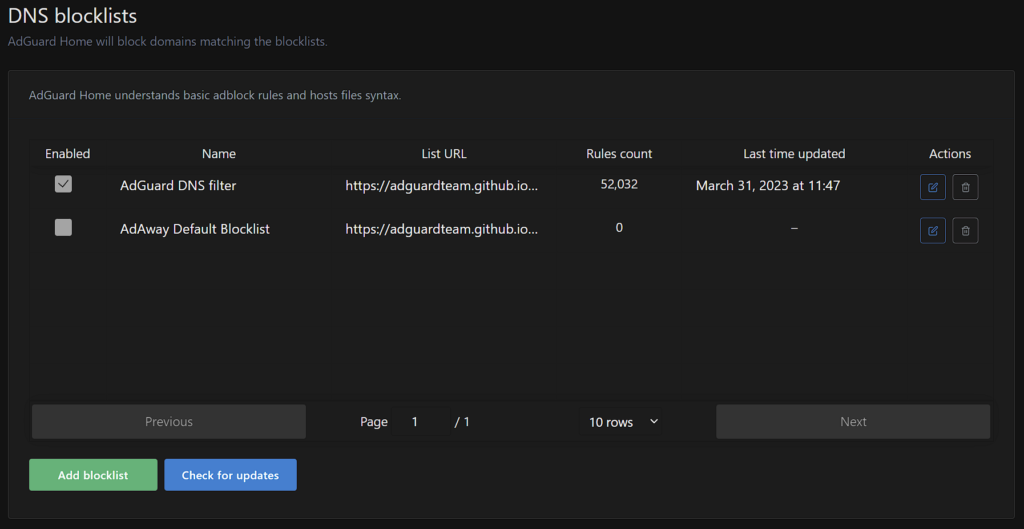
In Pi-hole, you can select Adlists, then add or remove blocklists.
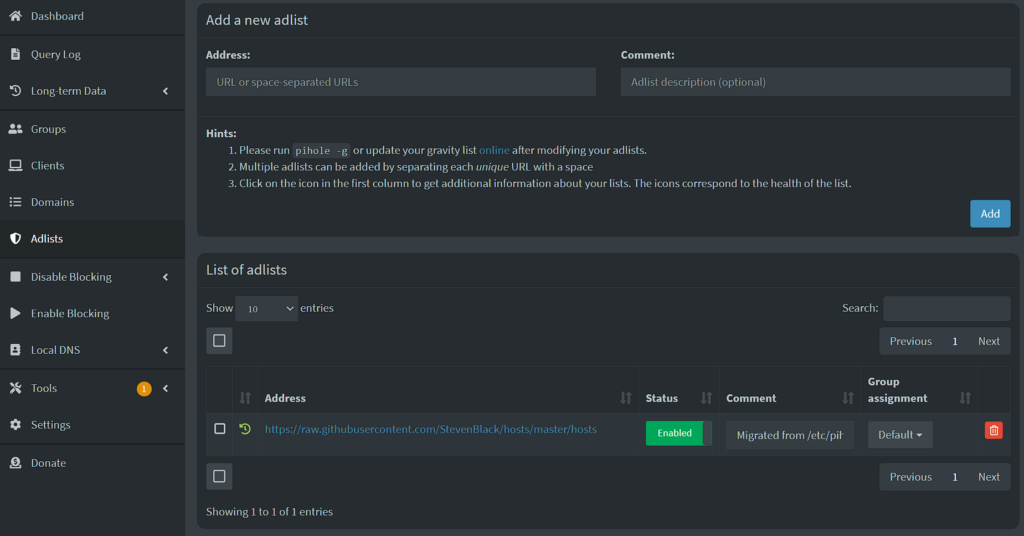
For this reason, the overall blocking ability of both is practically indistinguishable. However (as mentioned above), if you want to block more ads, it’s in your best interest to add multiple ad lists to enhance the functionality of either platform.
Local DNS Server for AdGuard Home or Pi-hole
When comparing the Local DNS capabilities of AdGuard Home vs. Pi-hole, DNS can be managed by AdGuard Home and Pi-hole, but Pi-hole’s implementation is significantly cleaner. Mainly because Pi-hole actually looks like it manages DNS and AdGuard Home is handled by using custom filtering rules.
This doesn’t make Pi-hole better than AdGuard Home, it’s just more logical. There are also most likely a lot of people who aren’t aware that they can use DNS with AdGuard Home due to the way it’s implemented.
To create DNS records in AdGuard Home, select Filters, Custom Filtering Rules, then add the local IP address and the hostname directly next to it. You can do this for as many devices as you’d like.
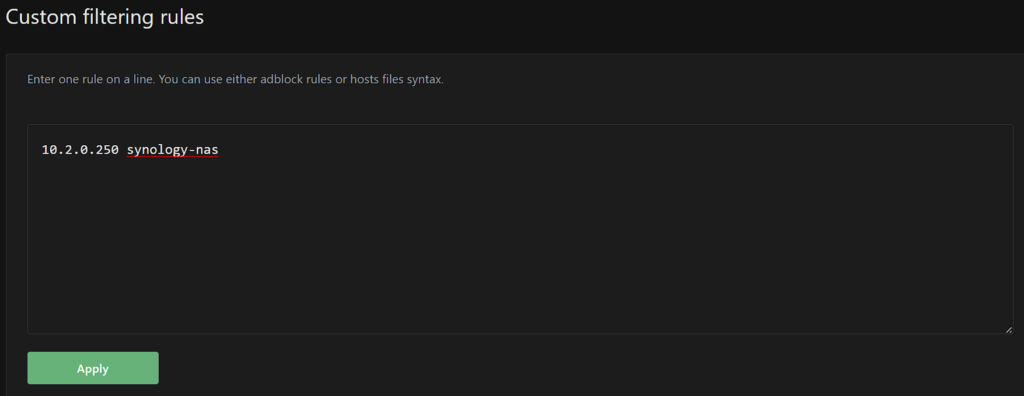
In Pi-hole, simply select Local DNS, then add the hostname and IP address. At the bottom, you’ll see all of the active Local DNS entries.
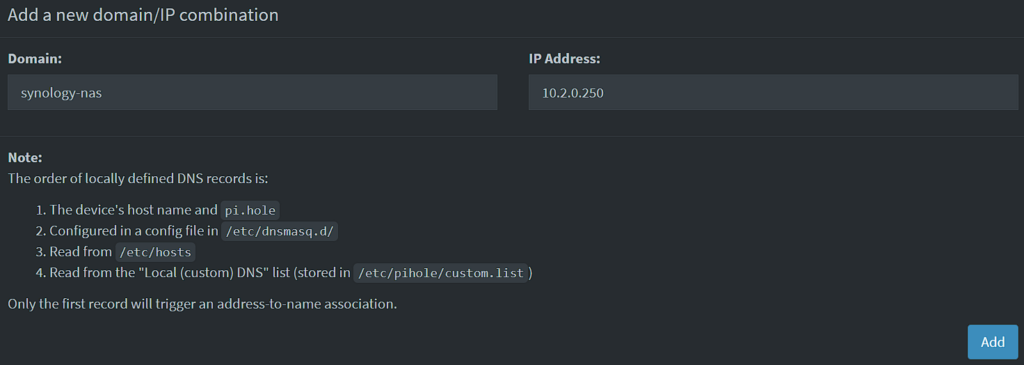
Speed & Performance: AdGuard Home vs. Pi-hole
When it comes to speed and performance, there are technically two areas. The first is on the server side (which is where AdGuard Home or Pi-hole runs), and the second is on a DNS level for web browsing.
DNS is fairly important when it comes to overall website performance as the faster the DNS query is returned, the faster the webpage can load. So we’re going to break this down into two sections below.
Server Performance: The server performance on AdGuard Home and Pi-hole are practically the same. Pi-hole uses slightly more memory with a basic configuration (roughly 30MB of memory more than AdGuard Home).
While there is a difference, this will not be noticeable on any device and the overall server performance isn’t something that should steer you in one direction or the other.
Website DNS Speeds: The overall performance of DNS queries is important when it comes to overall client website performance, but it’s drastically different for each individual user. Mainly because certain upstream DNS servers will perform faster than others based on your location.
Simply put, there wasn’t a noticeable or even measurable difference between both when it comes to overall DNS resolution (which makes sense when you look at what AdGuard Home and Pi-hole are actually doing).
You can set up Unbound which should have the best DNS performance overall, though it may take some time for that to happen (for caching purposes).
DNS-over-TLS, DNS-over-HTTPS, DNS-over-QUIC (Encrypted DNS)
Quite simply, AdGuard Home can use DNS-over-HTTPS (DoH), DNS-over-TLS (DoT), or DNS-over-QUIC (DoQ) right out of the box. It’s extremely easy to set up by selecting Settings, then Encryption Settings.
There are additional steps that must be configured to get this working, but the main point is that AdGuard Home handles this very easily right after the initial installation.
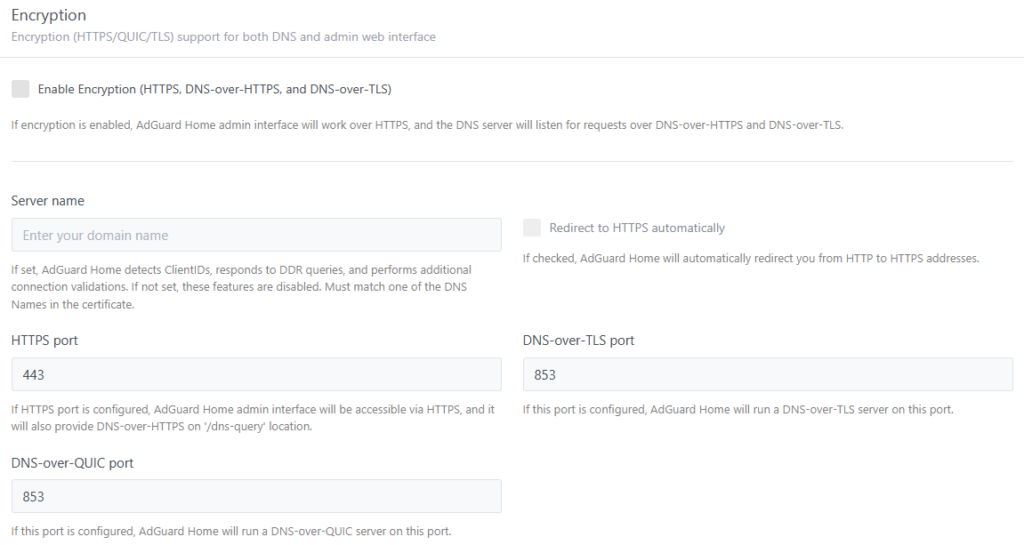
Pi-hole supports DNS-over-HTTPS and DNS-over-TLS as well, but the setup process is extremely different. Overall, if DoH, DoT, or DoQ is important to you and you actually plan on using it, AdGuard Home will handle it much easier.
As mentioned above, you can configure Unbound (DNS resolver) on AdGuard Home or Pi-hole as well!
User Interface: AdGuard Home vs. Pi-hole
When comparing the AdGuard Home vs. Pi-hole user interface, they both tend to have fairly easy user interfaces to work with, but I find the Pi-hole interface to be more logical.
Navigating through AdGuard Home is done from the top menu bar. The issue I find with AdGuard Home’s user interface is from a navigational standpoint. I find some of the headings to be confusing and oftentimes, I have to go through various sections before I find what I’m looking for.

Pi-hole, on the other hand, is extremely logical (at least to me). Everything is managed on the left side in different menus and I find that the sections you’re looking for are pretty easy to find. The whole user interface just feels like it’s laid out better and easier to use.

I admit that this is extremely subjective and while I find Pi-hole to be more logical, others may find AdGuard Home to be more logical.
Support – AdGuard Home vs. Pi-hole
One of the most interesting things to plan for is the inevitability of issues that require support. One of the things I always like to take into consideration when comparing two products is their overall search volume.
This helps me determine which product or service is more popular and the overall possibility of getting support for the issue(s) or enhancements that I’d like to implement.
As you can see below when comparing AdGuard Home vs. Pi-hole, it isn’t even close. For one reason or another, Pi-hole is significantly more popular than AdGuard Home. This isn’t something that should necessarily impact your decision, but it is important to look at it from an overall support level.
Quite simply, you’ll probably be able to get better support online with Pi-hole than you can with AdGuard Home.
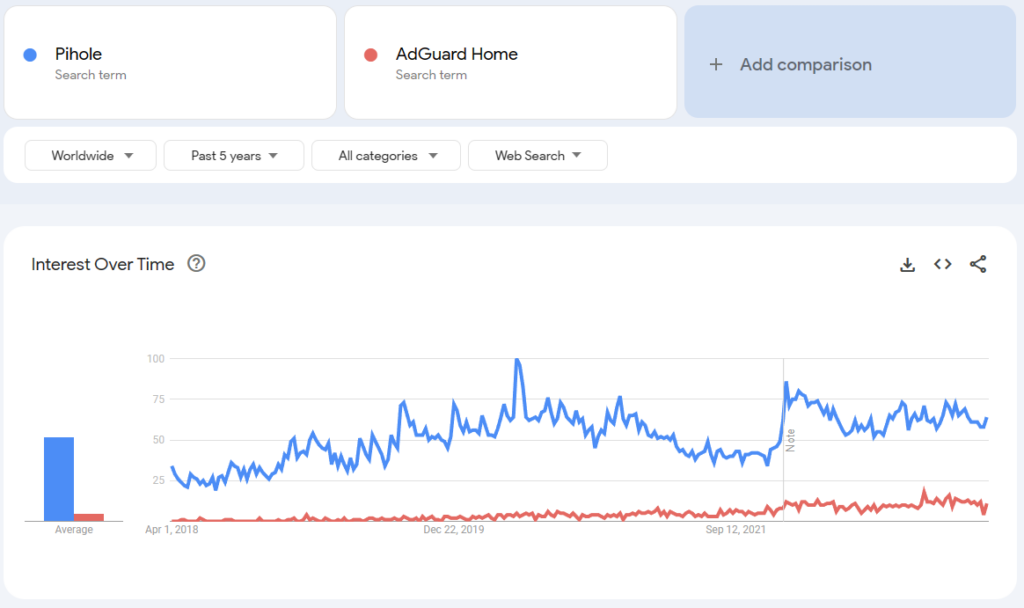
Pi-hole vs. AdGuard Home Verdict: Go with Pi-hole
This article looked at AdGuard Home vs. PiHole to determine which ad-blocking solution is best for your home network. While the two applications are extremely similar and overall do the same thing, Pi-hole, an open-source software, is the better choice for most people.
From a base functionality perspective comparing AdGuard Home vs. Pi-hole, Pi-hole is extremely easy to work with and has tons of great resources online to use. I also find the user interface to be significantly easier to work with and things appear to be laid out more logically (just look at the local DNS records section).
The exception to the statement above is if you want to set up DNS-over-HTTPS, DNS-over-TLS, or DNS-over-QUIC. Overall (at this point in time), it’s easier to set that up using AdGuard Home. With that said, I find that the majority of people aren’t interested in setting that up, and simply want to block ads, which is another reason to stick with Pi-hole as it’s the better choice for most people.
There are also many other similarities to Pi-hole and AdGuard Home, like built-in DHCP server functionality, the ability to integrate them into tools like Home Assistant, and more. Please keep in mind that you can install AdGuard Home or Pi-hole on various devices and we have various tutorials on AdGuard or Pi-hole!
Thanks for checking out the article on AdGuard Home vs. Pi-hole. If you have any questions on AdGuard Home vs. Pi-hole, please leave them in the comments!




